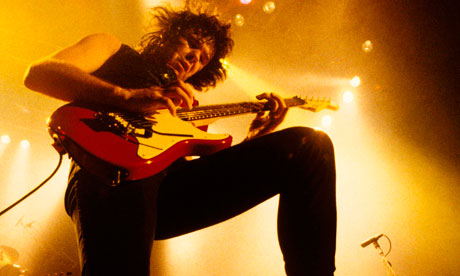While the Belfast-born guitarist Gary Moore, who has died unexpectedly aged 58, won popular acclaim for his work with the band Thin Lizzy, the scope of his talents reached far beyond mainstream hard rock. He was a fine blues guitarist and adept in the complexities of jazz-rock, and, in a career that began in the late 1960s, he ran the gamut of musical styles in a variety of groups and a long list of solo albums. His most recent disc was Bad for You Baby, from 2008.
He grew up near the Stormont estate off the Upper Newtownards Road in east Belfast. His father ran the Queen's Hall ballroom in Holywood, a seaside resort 10 miles from the city, and took the young Gary to see the showbands who performed there regularly, playing pop cover versions and country and western tunes. He recalled how his father invited him to sing with one of the bands when he was six. "I sang a song called Sugar Time. That was it. I had the bug."
After his father bought him a guitar from one of the showband musicians, he began teaching himself Shadows and Beatles songs. At 11, he played with his first band, the Beat Boys, who wore pudding-basin haircuts and played Beatles hits. His first professional job was with the Dublin band Skid Row, originally a quartet featuring Phil Lynott on vocals, though Lynott was sacked within months of Moore's arrival.
In 1966 Skid Row supported Fleetwood Mac at Dublin's National Stadium, and Mac's guitarist Peter Green, whose guitar work with John Mayall's Bluesbreakers had been another formative influence on Moore, was impressed by Moore's playing. They struck up a friendship, and a few years later Green sold Moore his superb 1959 Gibson Les Paul guitar for £100.
Moore became frustrated with Skid Row's limitations and quit, though without a clear direction in mind. He made the solo album Grinding Stone (1973), but was happy to accept an offer to join Lynott's group Thin Lizzy, replacing the guitarist Eric Bell. "The pressure was off and I was having fun," Moore recalled, "but after a few months I was doing myself in, drinking and high on the whole thing."
Sensing that he needed a more disciplined environment, Moore then joined the jazz-fusion group Colosseum II, formed by the drummer Jon Hiseman. Moore recorded three albums with them, which achieved only limited success, and felt that he lacked the theoretical knowledge required.
He rejoined Thin Lizzy in 1978, replacing an injured Brian Robertson for an imminent American tour with Queen. After playing on Lizzy's album Black Rose: A Rock Legend, Moore resumed his solo career with the album Back On the Streets, with assistance from Lynott. This contained Moore's best-known solo hit, Parisienne Walkways, a UK top 10 hit in April 1979. He set up camp in Los Angeles, and formed the band G-Force. The outfit made one album, which flopped. Once again, Lynott lured him back into the Lizzy fold, but Lynott was becoming increasingly dependent on drink and drugs, and the band was subsiding into chaos. Moore played on Lizzy's album Life/Live (1983), then quit again. A string of solo albums around this time included Corridors of Power (1982), Victims of the Future (1983) and Run for Cover (1985). The latter included the top five single Out in the Fields. This was his last collaboration with Lynott, who died in January 1986.
Wild Frontier (1987) was Moore's homage to traditional Irish music, and was partially prompted by the Self-Aid benefit concert for Ireland's unemployed. After that he veered back towards hard rock with After the War (1989), his record company and management having convinced him that this was the way to achieve better sales in the US. But in the midst of touring the new material, it dawned on Moore that his real love was the blues. "I didn't want to end up in Hollywood having facelifts and my hair dyed blond so I could appear on my own album cover," as he put it.
The upshot was Still Got the Blues (1990), which featured seasoned bluesmen Albert Collins and Albert King as well as George Harrison. It became regarded as perhaps Moore's most artistically successful solo effort. In 1992 he released a follow-up, After Hours, which again featured Collins as well as a cameo appearance by BB King on Since I Met You Baby.
"He was the nicest guy I ever worked with," Moore commented of BB King. "There was no ego trip. It's inspiring to be around people like that."
In 1994, Moore combined with former Cream musicians Ginger Baker and Jack Bruce in BBM, Moore standing in Eric Clapton's place in the Cream lineup. They released the album Around the Next Dream. The following year, he took yet another look back at the blues influences from his past with Blues for Greeny, a collection of cover versions of songs written by or associated with Green. By this time, Green had long since vanished from the music industry and was living the life of a recluse. "Peter's style of playing is just as important as Eric [Clapton]'s or Jeff [Beck]'s, but because he wasn't around to promote himself, he was forgotten," said Moore. "The restraint and the emotional content was far above anything else at that time."
Subsequent releases such as Back to the Blues, Power of the Blues and Old New Ballads Blues continued to display Moore's rediscovered passion for the blues. Close As You Get (2007), another blues collection, found Moore reunited with former Thin Lizzy drummer Brian Downey, while Bad for You Baby (2008)mixed original Moore compositions with blues standards.
Moore was found dead in his room at a hotel in Estepona, on the Spanish coast to the west of Marbella. Bob Geldof commented that Moore was "without question one of the great Irish bluesmen. His playing was exceptional and beautiful. We won't see his like again." Thin Lizzy's Scott Gorham added that "playing with Gary during the Black Rose era was a great experience. He was a great player and a great guy."
Moore is survived by his sons Jack and Gus from his first marriage, and his daughter Lilly from a recent relationship.
• Robert William Gary Moore, guitarist and singer, born 4 April 1952; died 6 February 2011











